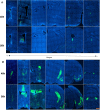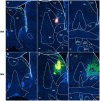Whole-brain mapping of projection from mouse lateral septal nucleus
- PMID: 31208998
- PMCID: PMC6679409
- DOI: 10.1242/bio.043554
Whole-brain mapping of projection from mouse lateral septal nucleus
Abstract
The lateral septal nucleus (LS) plays a critical role in emotionality, social behavior and feeding processes, through neural connections with the hippocampus and hypothalamus. We investigated the neural circuits of LS by using herpes simplex virus 1 strain H129 (H129) and pseudorabies virus stain Bartha (PRV). Virus H129 indicates that LS directly projects to some cerebral nuclei (nucleus accumbens, bed nuclei of the stria terminalis and amygdala), part of the hypothalamus (median preoptic, paraventricular, dorsomedial nucleus and lateral area), thalamus (medial habenula, the paraventricular, parataenial and reuniens nuclei, and the medial line nuclei) and the pontine central gray. Then the LS has secondary projections to the CA3 and CA1 field of the hippocampal formation, lateral and medial preoptic area, and the mammillary body. PRV tracing shows that LS are mainly receiving primary inputs from the amygdala, hippocampus, hypothalamic, thalamus, midbrain and hindbrain, and secondary inputs from dorsal and central linear nucleus raphe, the lateral part of the superior central nucleus raphe, the ventral anterior-lateral complex, the intermediodorsal nucleus, the central medial nucleus, the rhomboid nucleus, and the submedial nucleus of the thalamus. The neural circuit data revealed here could help to understand and further research on the function of LS.
Keywords: H129; Lateral septal nucleus; Neural circuits; Neural projection; PRV.
© 2019. Published by The Company of Biologists Ltd.
Conflict of interest statement
Competing interestsThe authors declare no competing or financial interests.
Figures







Similar articles
-
The connections of the septal region in the rat.J Comp Neurol. 1979 Aug 15;186(4):621-55. doi: 10.1002/cne.901860408. J Comp Neurol. 1979. PMID: 15116692
-
Projections of the ventral premammillary nucleus.J Comp Neurol. 1992 Oct 8;324(2):195-212. doi: 10.1002/cne.903240205. J Comp Neurol. 1992. PMID: 1430329
-
A PHA-L analysis of ascending projections of the dorsal raphe nucleus in the rat.J Comp Neurol. 1991 Nov 22;313(4):643-68. doi: 10.1002/cne.903130409. J Comp Neurol. 1991. PMID: 1783685
-
Optogenetic strategies to investigate neural circuitry engaged by stress.Behav Brain Res. 2013 Oct 15;255:19-25. doi: 10.1016/j.bbr.2013.05.007. Epub 2013 May 16. Behav Brain Res. 2013. PMID: 23684554 Free PMC article. Review.
-
Connections of the rat lateral septal complex.Brain Res Brain Res Rev. 1997 Sep 19;24(2-3):115-95. doi: 10.1016/s0165-0173(97)00009-x. Brain Res Brain Res Rev. 1997. PMID: 9385454 Review.
Cited by
-
A limbic circuit selectively links active escape to food suppression.Elife. 2020 Sep 7;9:e58894. doi: 10.7554/eLife.58894. Elife. 2020. PMID: 32894221 Free PMC article.
-
Excitatory neurons in paraventricular hypothalamus contributed to the mechanism underlying acupuncture regulating the swallowing function.Sci Rep. 2022 Apr 6;12(1):5797. doi: 10.1038/s41598-022-09470-9. Sci Rep. 2022. PMID: 35388042 Free PMC article.
-
Transcriptomic changes associated with maternal care in the brain of mouthbrooding cichlid Astatotilapia burtoni reflect adaptation to self-induced metabolic stress.J Exp Biol. 2023 Feb 15;226(4):jeb244734. doi: 10.1242/jeb.244734. Epub 2023 Feb 23. J Exp Biol. 2023. PMID: 36714987 Free PMC article.
-
Brain-Wide Mapping of Afferent Inputs to Accumbens Nucleus Core Subdomains and Accumbens Nucleus Subnuclei.Front Syst Neurosci. 2020 Mar 18;14:15. doi: 10.3389/fnsys.2020.00015. eCollection 2020. Front Syst Neurosci. 2020. PMID: 32317941 Free PMC article.
-
A novel H129-based anterograde monosynaptic tracer exhibits features of strong labeling intensity, high tracing efficiency, and reduced retrograde labeling.Mol Neurodegener. 2022 Jan 10;17(1):6. doi: 10.1186/s13024-021-00508-6. Mol Neurodegener. 2022. PMID: 35012591 Free PMC article.
References
-
- Chee S. S. and Menard J. L. (2011). Lesions of the dorsal lateral septum do not affect neophagia in the novelty induced suppression of feeding paradigm but reduce defensive behaviours in the elevated plus maze and shock probe burying tests. Behav. Brain Res. 220, 362-366. 10.1016/j.bbr.2011.02.027 - DOI - PubMed
LinkOut - more resources
Full Text Sources
Miscellaneous

